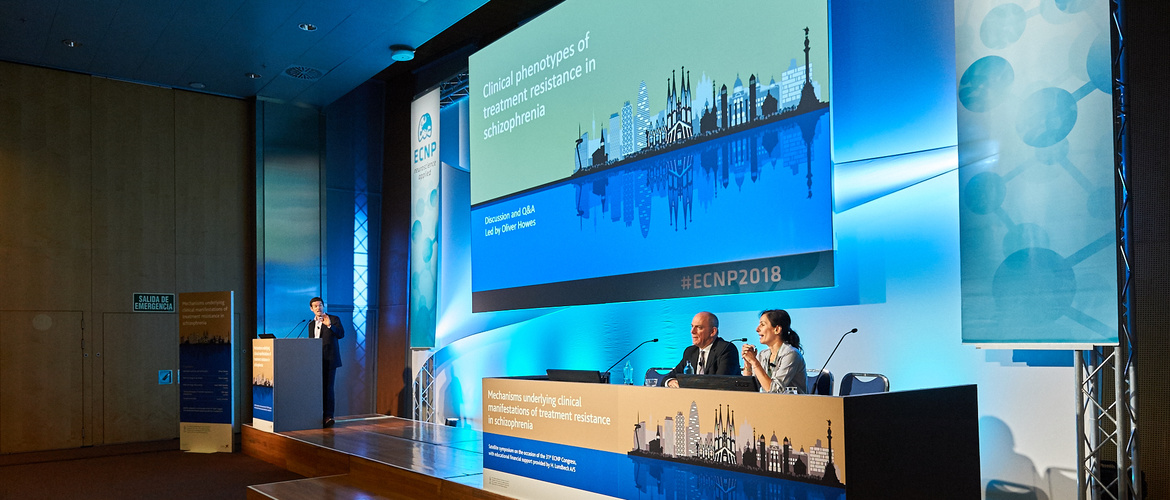
Choose a channel
Check out the different Progress in Mind content channels.

Progress in Mind

Antipsychotics are not effective in 30% of patients with schizophrenia. These patients have treatment-resistant schizophrenia (TRS). Hypotheses for the neurobiological mechanisms implicated in TRS include dopamine supersensitivity and normal striatal dopamine neurotransmission. Experts from the UK and Canada provided a comprehensive overview of current understanding of the neurobiology for TRS, considered how dopamine supersensitivity might be prevented or attenuated, and highlighted the need for new treatment targets at a symposium that had ECNP delegates crowding to get into a packed auditorium.
National and international treatment guidelines are broadly aligned on the definition of TRS,1–3 said Oliver Howes, Professor of Molecular Psychiatry, King’s College London, UK. The common definition is no significant improvement in target symptoms after treatment with at least two different antipsychotics at an adequate dose and duration.
All licensed antipsychotic drugs act through antagonism (or partial agonism) at the dopamine D2 receptor,4 Professor Howes explained. However, multiple antipsychotic trials are not effective for approximately one-third of patients.5 It is therefore clear that a different approach to treatment is required, he said.
For 10–23% of people with schizophrenia, antipsychotics are never effective
Non-response may be primary, from the first episode, or secondary. Rates of primary treatment resistance range from 10–23%.5–8
Patients for whom dopamine D2 blockers are not effective may have a normodopaminergic profile, said Professor Howes, with normal striatal dopamine synthesis and release capacity1 and normal dopaminergic synapse density.9–12
In contrast, patients for whom dopamine D2 blockers are effective have a hyperdopaminergic profile with elevated striatal dopamine synthesis and release capacity,1 and a higher density of dopaminergic synapses.9–12
Professor Howes suggested that other neurotransmitter systems might also be implicated in TRS, including glutamate.13,14 Glutamate levels are significantly higher in patients with TRS compared to healthy volunteers,13 and patients with schizophrenia for whom D2 antagonists are effective.14
Other neurotransmitter systems that might be implicated in TRS include glutamate
Professor Howes also noted that other factors could contribute to TRS including D2/3 upregulation,15 neurodegeneration,16 reduced brain connectivity,17,18 substance misuse,19 genetic polymorphisms,20 neuroinflammation,21 abnormally low levels of cannabinoid receptor 1,22 and white matter integrity.23
Chronic antipsychotic treatment leads to changes in the brain, said Anne-Noël Samaha, Associate Professor of Pharmacology, University of Montreal, Canada, and – in animal models --some of these changes result in treatment tolerance. A possible reason for this is that prolonged antipsychotic exposure leads to compensatory changes and brain supersensitivity to dopamine receptor stimulation, resulting in exaggerated responses to dopamine.24,25
Such supersensitivity has been demonstrated in rats,26 Dr Samaha explained. The loss of efficacy occurred despite clinically relevant levels of dopamine D2/3 receptor occupancy and was not linked to changes in dopamine release or availability; but it was accompanied by upregulation of D2/3 receptors.26
Supersensitivity was more obvious with the strong D2 blockade achieved by typical antipsychotics, which bind tightly to the receptor. It was less evident with atypicals, when less tight binding allows for some endogenous dopamine transmission.
Intermittent antipsychotic treatment in a rat model does not cause dopamine supersensitivity27
Dr Samaha commented that in other words less may be more and that transient but regular antipsychotic treatment strategies need to be investigated further.
Once it has developed, antipsychotic-induced dopamine supersensitivity has been shown to be attenuated by:
5-HT2A antagonism attenuates dopamine supersensitivity
TRS differs from treatment-responsive schizophrenia clinically and biologically,30 said Ofer Agid, Associate Professor of Psychiatry, Toronto, Canada, and potentially there are different types of TRS,31,32 with different neurobiologies, psychopathologies, and clinical courses.33,34
Current antipsychotics do not improve symptoms for patients with TRS
Professor Agid highlighted how current antipsychotics do not significantly improve symptoms for patients with TRS as demonstrated by:
Antipsychotic effectiveness also declines with each relapse.38,39
Professor Agid described the continuum and categorical hypotheses for TRS.34 According to the continuum hypothesis, the same pathophysiological processes underlie symptoms in patients for whom antipsychotics are effective and ineffective, but occur to a greater degree in TRS. In contrast, the categorical hypothesis states that TRS has a fundamentally different pathophysiology from that of responsive schizophrenia, and existing treatments are ineffective because they target the wrong processes.
Professor Agid concluded that a hybrid of both the continuum and categorical hypotheses might best describe the neurobiology of TRS.
Educational financial support for this Symposium was provided by H. Lundbeck A/S